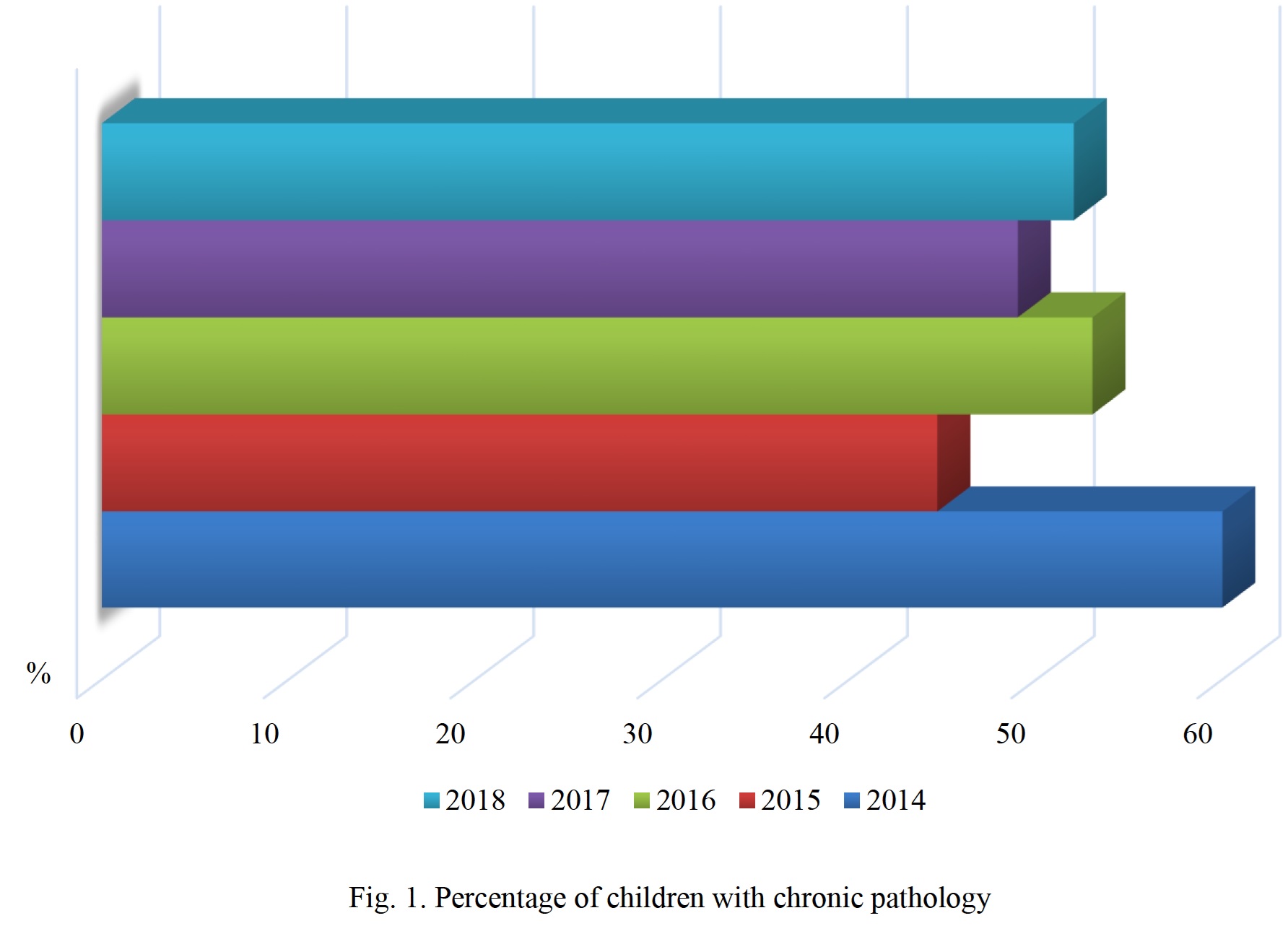Study of children's health of preschool age
DOI:
https://doi.org/10.15587/2519-4798.2023.289888Keywords:
health status, children, preschool age, medical cards, morbidity, organ systemsAbstract
A strategically important and priority task of the state in the field of health care is to preserve the life and health of children.
The aim is to analyze the state of health of preschool children during 2014-2018 to determine the main diseases and influencing factors.
Materials and methods. The analysis of medical records of children aged 2-6 years was carried out in a preschool educational institution (PEI) in the city of Kharkiv (Shevchenkivskyi district) for the period 2014-2018. The analysis was carried out in accordance with the current legislation of Ukraine.
Results. The maximum percentage of children with chronic pathology was recorded in 2014. During the next 4 years, a decrease in the percentage of children with pathologies was observed, but this indicator remained at a high level. Among the pathologies, speech defects, whose frequency were recorded, which were evenly distributed among children aged 3-6 years. On the part of the organs of vision, isolated cases of strabismus, astigmatism and hypermetropia were recorded. Pathological conditions of the respiratory system - adenoid vegetations were registered in children aged 4-6 years. The maximum percentage among pathologies was anemia, which was noted more often in children aged 4-5 years. Pathologies of the digestive system - gastritis, hernia, and liver diseases were registered to the maximum in 2014, and then a decrease in their number was observed. Obesity, as a pathology associated with endocrine dysfunction, tended to increase but did not depend on the age of children. During preventive medical examinations, posture disorders and flat feet were more often registered among diseases of the musculoskeletal system. From the genitourinary system, pyelonephritis was registered.
Conclusion. A comparison of the morbidity of preschool children revealed an increase in the number of pathologies from the endocrine (obesity), nervous, genitourinary (pyelonephritis) and circulatory systems (anaemia)
References
- Tsili Staloho Rozvytku: Ukraina: natsionalna dopovid. (2017). Ministerstvo ekonomichnoho rozvytku i torhivli Ukrainy. Available at: https://www.kmu.gov.ua/storage/app/sites/1/natsionalna-dopovid-csr-Ukrainy.pdf
- Janus, M., Reid-Westoby, C., Raiter, N., Forer, B., Guhn, M. (2021). Population-Level Data on Child Development at School Entry Reflecting Social Determinants of Health: A Narrative Review of Studies Using the Early Development Instrument. International Journal of Environmental Research and Public Health, 18 (7), 3397. doi: https://doi.org/10.3390/ijerph18073397
- Paik, L. (2022). The Influence of Family Multi-Institutional Involvement on Children’s Health Management Practices. Children, 9 (6), 828. doi: https://doi.org/10.3390/children9060828
- Under-five mortality (2023). United Nations Inter-agency Group for Child Mortality Estimation (UN IGME). Available at: https://data.unicef.org/topic/child-survival/under-five-mortality
- Niankovskyi, S. L., Ivakhnenko, O. S., Dobrianskyi, D. O. (2010). Osoblyvosti profilaktyky i diietoterapii kharchovoi alerhii u ditei rannoho viku. Zdorove rebenka, 6 (27), 71–77.
- Kruk, M. E., Gage, A. D., Arsenault, C., Jordan, K., Leslie, H. H., Roder-DeWan, S. et al. (2018). High-quality health systems in the Sustainable Development Goals era: time for a revolution. The Lancet Global Health, 6 (11), e1196–e1252. doi: https://doi.org/10.1016/s2214-109x(18)30386-3
- Merkulova, N. (2023). Sered zhakhiv viiny. U 75 % ditei Ukrainy travmovana psykhika. Gromada Group. Available at: https://gromada.group/news/statti/23944-sered-zhahiv-vijni-u-75-ditej-ukrayini-travmovana-psihika
- Merkulova, N. (2023). Sered zhakhiv viiny. U 75 % ditei Ukrainy travmovana psykhika. Gromada
- Purnell, J. Q. (2023). Definitions, Classification, and Epidemiology of Obesity. Available at: https://www.ncbi.nlm.nih.gov/books/NBK279167/
- Balogh, E. P., Miller, B. T., Ball, J. R. (2015). Improving Diagnosis in Health Care. The National Academies of Sciences, Engineering, and Medicine. doi: https://doi.org/10.17226/21794
- Luk′ianova, O. M. (2015). Problemy zdorov’ia zdorovoi dytyny ta naukovi aspekty profilaktyky yoho porushen. Mystetstvo likuvannia, 2, 6–15.
- Heliotis, I., Whatling, R., Desai, S., Visavadia, M. (2021). Primary herpetic gingivostomatitis in children. BMJ, 31, e065540. doi: https://doi.org/10.1136/bmj-2021-065540
- Monaghan, M., Bryant, B. L., Inverso, H., Moore, H. R., Streisand, R. (2022). Young Children with Type 1 Diabetes: Recent Advances in Behavioral Research. Current Diabetes Reports, 22 (6), 247–256. doi: https://doi.org/10.1007/s11892-022-01465-0
- Tosif, S., Baker, A., Oakley, E., Donath, S., Babl, F. E. (2012). Contamination rates of different urine collection methods for the diagnosis of urinary tract infections in young children: An observational cohort study. Journal of Paediatrics and Child Health, 48 (8), 659–664. doi: https://doi.org/10.1111/j.1440-1754.2012.02449.x
- Bielorus, O. H. (2014). Aktualni pytannia infektsii sechovoi systemy u ditei. Available at: https://np.pl.ua/2014/11/aktualni-pytannya-infektsij-sechovoji-systemy-u-ditej/
- André, H. P., Sperandio, N., Lopes de Siqueira, R., do Carmo Castro Franceschini, S., Priore, S. E. (2018) Food and nutrition insecurity indicators associated with iron deficiency anemia in Brazilian children: a systematic review. Ciência & Saúde Coletiva, 23 (4), 1159–1167. doi: https://doi.org/10.1590/1413-81232018234.16012016
- Howard‐Jones, A. R., Burgner, D. P., Crawford, N. W., Goeman, E., Gray, P. E., Hsu, P. et al. (2021). COVID 19 in children. II: Pathogenesis, disease spectrum and management. Journal of Paediatrics and Child Health, 58 (1), 46–53. doi: https://doi.org/10.1111/jpc.15811

Downloads
Published
How to Cite
Issue
Section
License
Copyright (c) 2023 Olena Dolzhykova , Rymma Yeromenko, Olena Matviichuk

This work is licensed under a Creative Commons Attribution 4.0 International License.
Our journal abides by the Creative Commons CC BY copyright rights and permissions for open access journals.
Authors, who are published in this journal, agree to the following conditions:
1. The authors reserve the right to authorship of the work and pass the first publication right of this work to the journal under the terms of a Creative Commons CC BY, which allows others to freely distribute the published research with the obligatory reference to the authors of the original work and the first publication of the work in this journal.
2. The authors have the right to conclude separate supplement agreements that relate to non-exclusive work distribution in the form in which it has been published by the journal (for example, to upload the work to the online storage of the journal or publish it as part of a monograph), provided that the reference to the first publication of the work in this journal is included.








